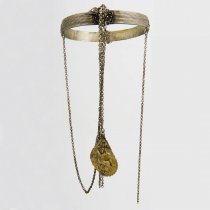A byzantine Hodegetria
Icon of the Virgin Hodegetria.
Late 13th century.
BXM 989
The icon was handed over to the Byzantine and Christian Museum by the Committee of the Asia Minor Refugee Heirlooms on December 18 1925, accompanied by a proof of receipt. No reference to the icon’s exact provenience has been made in the receipt or the inventory of the refugee heirlooms compiled later, from 1928 onwards, by the then Director of the Museum, Georgios Soteriou. In addition, we are unaware of the exact date of the icon’s arrival in Greece.Hence, the question as to whether the icon reached us from Eastern Thrace and the western regions of Asia Minor (namely the places from which the refugee heirlooms normally came during the early years of the displacement, 1922–1923) or whether it originates in Cappadocia or Pontus (the places to which the heirlooms of the exchanged Christian populations usually belonged, 1924–1925) can only be answered based on clues provided by the icon itself as a work of art.
In the context of thisenquiry, a view has been expressed, according to which, the icon comes from Trebizond —a rather uncertainhypothesis. In any case, the work constitutes a superb example of the so-called Palaeologan painting and, evidently, it was deeply venerated by the community that owned it. The icon was originally rectangular, but was later cut to fit in its new position, possibly an iconostasis. When it arrived in the country, it featured overpainted areas that were removed during conservation.
In 1930, when the Byzantine and Christian Museum was transferred from the ground floor of the Academy of Athens to “Villa Ilissia” (the palace of the Duchess of Plaisance), Georgios Soteriouexhibited the byzantine icons of the Museum’s collection in the so-called Room I, on the mansion’s first floor. In the Guide to the Byzantine Museum, published in 1931, Soteriou recounts that above the entrance of the Icons’ Room I, he had installed an old icon of the Virgin in bust, of the Hodegetria type, dating to the 15th century, that belonged to the refugee heirlooms, originating in Adrianople.The Byzantine Museum’s Refugee Heirlooms Collection did not contain an icon with similar features, nor was such an icon ever recorded in the relevant inventory. Only two refugee icons somewhat match the description in the Guide. One of them is put on display here which, based on the Guide, had been mounted on the north wall of Room I.The second icon of the Virgin Hodegetria, possibly identified with the one under discussion, is a refugee heirloom now dated to the 16th century (BXM 11254), which is not mentioned in the Guide as one of the icons exhibited in Room I (placedabove the entrance). On the other hand, as stated inarchival material, its place of origin is Koutali Island in the Sea of Marmara (Propontis), not Adrianople. Consequently, for the time being, the question as to which was the refugee heirloom displayed by Georgios Soteriou in thispivotal position in the Museum’s first permanent exhibition cannot be definitively answered. The icon presented here (BXM 989) remained on the first floor of “Villa Ilissia” until 2004, when it was moved to the new permanent exhibition of the Museum.










 Purple Gospel
Purple Gospel .jpg) The double-sided icon from Tuzla
The double-sided icon from Tuzla .jpg) An emblematic refugee “relic”
An emblematic refugee “relic”  A byzantine Hodegetria
A byzantine Hodegetria  An Evangelistary from Trebizond
An Evangelistary from Trebizond .jpg) A significant Palaeologan work
A significant Palaeologan work  Tetraevangelion from Adrianople
Tetraevangelion from Adrianople .jpg) A Cretan icon from Eastern Thrace
A Cretan icon from Eastern Thrace .jpg) “Joined in matrimony”
“Joined in matrimony”  A peculiar neckband
A peculiar neckband  Fragmented memory
Fragmented memory .jpg) Zumzud, the pilgrim
Zumzud, the pilgrim .jpg) A refugee heirloom in “Russian style”
A refugee heirloom in “Russian style” .jpg) An unusual “icon” from Cappadocia
An unusual “icon” from Cappadocia .jpg) "He (the Lord) keeps all their bones …" (Psalm 33: 21)
"He (the Lord) keeps all their bones …" (Psalm 33: 21) .jpg) A Karamanli icon
A Karamanli icon 



